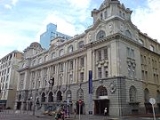
Britomart Transport Centre
Encyclopedia
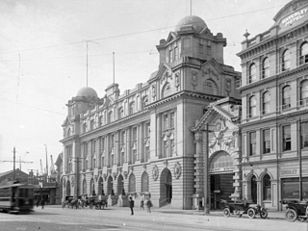
Central business district
A central business district is the commercial and often geographic heart of a city. In North America this part of a city is commonly referred to as "downtown" or "city center"...
public transport hub of Auckland
Auckland
The Auckland metropolitan area , in the North Island of New Zealand, is the largest and most populous urban area in the country with residents, percent of the country's population. Auckland also has the largest Polynesian population of any city in the world...
, New Zealand, and the northern terminus of the North Island Main Trunk line. It combines a bus interchange with a railway station in a former Edwardian
Edwardian architecture
Edwardian architecture is the style popular when King Edward VII of the United Kingdom was in power; he reigned from 1901 to 1910, but the architecture style is generally considered to be indicative of the years 1901 to 1914....
post office, extended with expansive post-modernist
Postmodern architecture
Postmodern architecture began as an international style the first examples of which are generally cited as being from the 1950s, but did not become a movement until the late 1970s and continues to influence present-day architecture...
architectural elements. It is located at the foot of Queen Street
Queen Street, Auckland
Queen Street is the major commercial thoroughfare in the Auckland CBD, Auckland, New Zealand's main population centre. It starts at Queens Wharf on the Auckland waterfront, adjacent to the Britomart Transport Centre and the Downtown Ferry Terminal, and runs uphill for almost three kilometres in a...
, the main commercial thoroughfare of Auckland CBD
Auckland CBD
The Auckland CBD is the geographical and economic heart of the Auckland metropolitan area. Bounded by several major motorways and by the harbour coastline in the north, it is surrounded further out by mostly suburban areas...
, with the main ferry terminal just across Quay Street.
The centre was the result of many design iterations, some of them being substantially larger and including an underground bus terminal. Political concerns and cost implications meant that these concepts did not proceed. However, at the time of its inception in the early 2000s, the centre was still Auckland's largest transport project ever, built to move rail access closer to the city's CBD
Central business district
A central business district is the commercial and often geographic heart of a city. In North America this part of a city is commonly referred to as "downtown" or "city center"...
and help boost Auckland's low usage of public transport
Public transport in Auckland
Public transport in Auckland, the largest metropolitan area of New Zealand, consists of three modes – bus, train and ferry. Services are provided under the "MAXX" brand by private transport providers, coordinated by Auckland Transport, the council controlled organisation that replaced the Auckland...
. It is one of the few underground railway stations in the world where diesel motive power is used.
Initially seen as underused and too costly, it is now considered a great success, though also heading for capacity with the growing uptake of rail commuting in the Auckland Region. Limitations on further patronage are primarily due to the access tunnel from the east which provides only two rail tracks, and the lack of a through connection (via a rail link to North Shore City or to the Western line
Western Line, Auckland
The Western Line in Auckland, New Zealand is the name given to suburban services that operate between Britomart and Waitakere via Newmarket.-Routing:...
via a city tunnel) which would change the station from a terminus to a through station.
History
Cost over-runs and differing tastes made Britomart politically controversial, the design often being described as a large hole in the ground, both literally and figuratively. Despite this and a NZ$204 million price tag, it has won numerous design awards and is internationally recognised for its innovative but heritage-sympathetic architecture. The main source of contention was the relatively great expense of this public transport development in the Auckland Region which is traditionally very focusedTransport in Auckland
Transport in Auckland, New Zealand's largest city, is defined by various factors, among them the shape of the Auckland isthmus , the suburban character of much of the Auckland area and the large car-ownership ratio of New Zealanders.These factors have resulted in a mostly...
on the private car.
Earlier uses
Britomart is on reclaimed land in the middle of what was once Commercial BayCommercial Bay
Commercial Bay was the bay on the southern side of the Waitemata Harbour, formerly defining the original extent of the Auckland waterfront, Auckland, New Zealand...
. It is named after Point Britomart
Point Britomart
Point Britomart is a former headland in the Waitemata Harbour, Auckland, New Zealand. Located between Commercial Bay and Official Bay, it was later quarried away to produce fill for land reclamation in Mechanics Bay, and no physical trace remains at street level in what is today an area of the...
, a former headland at Commercial Bay's eastern end. In the 1870s and 1880s the headland was levelled in order to extend the railway line to the bottom of Queen Street, and was used to fill in Commercial Bay.
The original Auckland railway station moved west to the Britomart site in 1885 and remained there after the Post Office was built on the Queen Street frontage in 1911. In 1930 it was relocated 1.2 km east to Beach Road, to the (now former) Auckland Railway Station
Auckland railway station
Auckland Railway Station is the former main railway station of Auckland, New Zealand, and is located on the eastern edge of the Auckland CBD near Mechanics Bay...
, and the site became a bus terminal (from 1937) and carpark (from 1958).
Many proposals were made to relocate the station back to the CBD, most notably in 1973 and 1987, with the 1970s proposal of the Mayor of Auckland, Dove-Myer Robinson
Dove-Myer Robinson
Sir Dove-Myer Robinson was Mayor of Auckland City from 1959 to 1965 and from 1968 to 1980, the longest tenure of any holder of the office....
, envisaging an underground station at the Britomart site as well as a tunnel loop, bit that was stopped by the Muldoon National Government
Third National Government of New Zealand
The Third National Government of New Zealand was the government of New Zealand from 1975 to 1984. It was an economically and socially conservative government, which aimed to preserve the Keynesian economic system established by the First Labour government while also being socially conservative...
as being too costly and unjustified. In 1995, Auckland City Council
Auckland City Council
Auckland City Council was the local government authority representing Auckland City, New Zealand, and was amalgamated into the Auckland Council on 1 November 2010. It was an elected body representing the 404,658 residents of the city...
purchased the old Post Office (with PostBank offices closed in 1988, though some postal services remained open beyond that year) and proposed to develop the area as a transit centre.
Early designs called for both the bus terminal and the railway to be underground, but these plans were scrapped as consultation showed that buses were preferred above ground by both users and operators, and projected costs soared, partly due to the difficulties with potential water ingress. The developer eventually defaulted on contractual deadlines, and the project failed.
In 1998, a cheaper option was decided on (partly by a now more receptive consultation process with stakeholders and general citizens). The architectural form was chosen via a competition process. The design used part of Queen Elizabeth II Square and surrounding streets as a bus terminal, with the existing dilapidated bus terminal redeveloped to incorporate both bus services and a pedestrianised area. When nearby Quay St was realigned in the late 1990s, a tunnel was built (completed in 2000) to provide the underground railway link to Britomart. Bus services using the old bus terminal were diverted to other locations in June 2001.
Construction
OverviewDesigned by California architect Mario Madayag in collaboration with local Auckland architects Jasmax, construction of Britomart commenced in October 2001, with structural design having been provided by OPUS. It involved 14 km of piling, some being 40 m long and driven 16 m into the underlying bedrock, mainly to provide good earthquake protection, and to futureproof the area for potential later construction of buildings on top of the station. 200,000 cubic metres were excavated for the station, and 40,000 cubic metres of concrete poured. The station has a site area of 5.2 ha and includes 236 m² retail area.
The main chamber of Britomart is one of the best interiors in New Zealand and shows the influence of the main hall of the Austrian Postal Savings Bank
Austrian Postal Savings Bank
The Austrian Postal Savings Bank building is a famous Jugendstil building in Vienna, designed and built by the architect Otto Wagner. The building is regarded as an important early work of modern architecture, representing Wagner's first move away from Art Nouveau and Neoclassicism...
building by Otto Wagner
Otto Wagner
Otto Koloman Wagner was an Austrian architect and urban planner, known for his lasting impact on the appearance of his home town Vienna, to which he contributed many landmarks.-Life:...
.
The new station was opened in July 2003 by Sir Edmund Hillary
Edmund Hillary
Sir Edmund Percival Hillary, KG, ONZ, KBE , was a New Zealand mountaineer, explorer and philanthropist. On 29 May 1953 at the age of 33, he and Sherpa mountaineer Tenzing Norgay became the first climbers known to have reached the summit of Mount Everest – see Timeline of climbing Mount Everest...
and several government ministers. Services to the old station ceased, except for some peak-time commuter services and excursion trains using the former Platform 4 (originally Platform 7), renamed 'The Strand'. The commuter services ceased after a few months.
Pedestrian underpasses
Initial plans included an underground pedestrian walkway connecting Britomart to Queen Elizabeth II Square, the nearby downtown ferry terminal and the main shopping street of Queen St. Due to cost over-runs only the short link to the square was built, the remainder replaced with a sizeable canopy over the footpath outside the station.
Further works
While no major works are currently planned for the station itself except for eventual installation of overhead wires, a major commercial building was built over the eastern approach tunnel in the late 2000s, at the eastern edge of the plaza behind the centre.Capacity and rail connections
The station is designed to serve up to 10,500 passengers during the peak hour in its current configuration as a terminus. Capacity increases will probably not be possible without turning Britomart into a through station, with a tunnel underneath Auckland CBD (see below).The station has five platforms, and is constrained by the 9.3 m width of the 426 m long access tunnel, which allows only two tracks. Early forecasts predicted that while double-tracking of the surrounding rail network would improve peak time train congestion, the capacity of the corridor would only be reached by around 2020. The recent growth in train patronage and increased services has meant that from 2011 the tunnel will be at maximum capacity, almost 10 years earlier than predicted. Because of the capacity restrictions, a proposed Hamilton-Auckland commuter train service will for the interim only go to the 'The Strand' station some 1.5km to the east.
Increased services
In its early days, Britomart received a lot of criticism due to it being built on a scale and level of grandeur that was well in excess of the capacity and patronage of the rail network in Auckland at the time. Auckland Regional CouncilAuckland Regional Council
The Auckland Regional Council was the regional council of the Auckland Region. Its predecessor the Auckland Regional Authority was formed in 1963 and became the ARC in 1989...
transport committee chairwoman Catherine Harland acknowledged that "Britomart opened ahead of its time", raising public expectations that the state of the rail network could not yet fulfil.
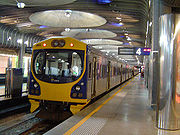
The foresight of council planners in constructing such an iconic investment in Auckland's public transport has already spurred further development. The $600 million Project DART (Developing Auckland's Rail Transport) is underway, with the state-owned enterprise ONTRACK
OnTrack
OnTrack was a regional rail line that operated in Syracuse, New York from 1994 to 2007. During its operation, Syracuse was the smallest city in the United States to have regional train service. The line ran from Colvin Street on the city's south side via Syracuse University and Armory Square to the...
undertaking the ‘below rail’ construction (i.e. platforms, tracks and signals) and ARTA providing the passenger services and facilities at stations (i.e. lighting, shelters and access), with funding from the Auckland Regional Council and Land Transport New Zealand.
Electrification
With the announcement on 17 May 2007 that electrification of Auckland's rail networkAuckland Railway electrification
The Auckland railway electrification has been proposed for several decades, but physical works only began in the late 2000s. After investment into new infrastructure and improved services created massive patronage gains on Auckland's commuter rail network in the middle 2000s, the long-discussed...
would proceed, changes will include installation of overhead wires, with the project expected to be complete in 2013. After the electification, diesel trains are to be phased out from suburban services and replaced by new electric trains that Auckland Transport (initially ARTA) is to purchase in the near future. However, a small number of diesel powered trains are likely to continue to use the station providing regional and intercity services to unelectrified network areas.
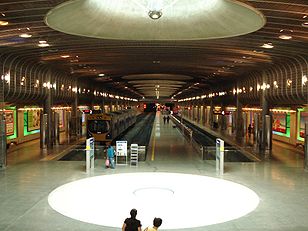
City underground tunnel
Plans for an underground tunnel from Britomart southward underneath the CBD to Mt Eden have been debated for nearly a century. This tunnel would allow trains to run through the station rather than having to reverse out over the same set of tracks. Governments have so far been unwilling to provide funding for this project and it is unlikely to proceed in the near future, though the major investments into public rail transport as decided on in 2007 have put it back on the drawing board. Current estimates for the cost of the loop are at around $1 billion, taking 5–7 years to plan and build.On 5 March 2008 ARTA said that it had begun preliminary planning for a 3.5 km tunnel which would most likely be travelling under Albert Street and serving three underground stations near Wellesley Street (linking to Aotea Square
Aotea Square
Aotea Square is a large paved public area in the CBD, of Auckland, New Zealand. Officially opened in 1979 by Sir Dove-Myer Robinson next to Queen Street, it is used for open-air concerts and gatherings, and markets and political rallies....
), in the Karangahape Road
Karangahape Road
Karangahape Road is one of the main streets in the central business district of Auckland, New Zealand. The massive expansion of motorways through the nearby inner city area - and subsequent flight of residents and retail into the suburbs - turned it from one of Auckland's premier shopping streets...
/ Pitt Street area, and one near Upper Symonds Street in Newton
Newton, New Zealand
Newton is a small suburb of Auckland City, New Zealand, under the local governance of the Auckland City Council. It had a population of 837 in the 2001 census....
, at the southern end linking to a redeveloped station at Mt Eden
Mt Eden Train Station
Mt Eden Railway Station is a Western Line station of the local railway network in the Mount Eden suburb of Auckland, New Zealand. It has an island platform, and is reached via a footbridge from Mt Eden Rd or from the level crossing between Ngahura Street and Fenton Street.- History :* 1880: Opened...
.
Eastern tunnel capacity
A proposed alternative to increase capacity is the duplication of the existing eastern Britomart approach tunnel. This would require a new twin track tunnel approximately 500 metres long to be constructed parallel to the existing twin-track tunnel, providing four tracks from Quay Park Junction and retaining Britomart as a terminus. Estimated costs are $150 million to $200 million, taking of 4–5 years to plan and build. Such a project would allow the same capacity increase as the CBD loop at approximately one sixth to one fifth the cost, but without any of the additional benefits that the two new CBD underground stations or the more direct route to the Western Line would provide.Initially seen as an inferior, but cheaper and more politically acceptable alternative to the CBD tunnel, the duplicate eastern approach is regaining favour due to the comparatively short build time. Even if planning commenced immediately the city underground loop might not become operational until several years after the maximum capacity of the existing corridor is reached. While seen as an alternative to the CBD through connection tunnel, a duplicate eastern tunnel would not preclude an underground line from being built.
Another option that will be in operation from early 2011 and will allow an increase in capacity of the existing tunnel is the use of 'bi-directional signalling', which will allow a train to leave on the same track that it entered - and which would free it from having to cross over other tracks which may not be safely clear of other trains yet.
Services

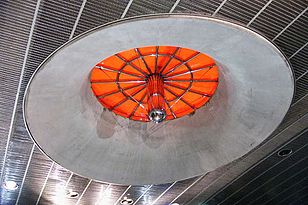
Trains
Suburban services are provided by VeoliaVeolia (New Zealand)
Veolia Transport Auckland, formerly Connex Auckland Ltd, is a division of Australasia's largest passenger train company, French-owned Veolia. It runs Auckland's urban passenger trains under contract from Auckland Transport under their MAXX brand, on infrastructure owned and managed by KiwiRail...
on behalf of Auckland Transport, under the MAXX brand name. Most services either commence from or terminate at Britomart. The suburban network extends to Pukekohe
Pukekohe
Pukekohe is a town in the Auckland Region of the North Island of New Zealand. Located at the southern edge of the Auckland Region, it is approximately 50 kilometres south of Auckland City, between the southern shore of the Manukau Harbour and the mouth of the Waikato River. The hills of Pukekohe...
in the south and Waitakere City in the north-west.
The Overlander, a daily (high summer) or thrice-weekly (off-season) long-distance train between Britomart and Wellington via the North Island Main Trunk is operated by Tranz Scenic
Tranz Scenic
Tranz Scenic is the long-distance passenger train brand of KiwiRail, formed from the New Zealand Railways Corporation InterCity Rail services. Tranz Scenic was renamed along with the other operating divisions of Tranz Rail in 1995...
, part of KiwiRail
KiwiRail
KiwiRail Holdings Limited is the rail operations subsidiary of the New Zealand Railways Corporation, which trades as KiwiRail. Headquartered in Wellington, New Zealand, KiwiRail is the largest rail transport operator in New Zealand. Since July 2010 John Spencer has been the Chairman...
. The service was threatened with closure in 2006 and its future remained uncertain even after Toll reversed its decision to suspend services after public comments on the closure were strongly negative.
Buses and ferries
Britomart is a major interchange where passengers can transfer between trains, buses and ferries. It is the terminus for many bus routes, and The Link and the free City Circuit buses go past on their loops around the city. Buses mainly depart from Queen Elizabeth II Square in front of Britomart, though the large number of routes means some depart from stops up to a block away. This lack of more integrated bus facilities is one of the less perfect outcomes of the final design, which cut the underground bus station due to costs reasons and because the bus operators preferred an above-ground solution.Just across Quay Street from Britomart is the Auckland Ferry Terminal, serving suburbs such as Devonport
Devonport, New Zealand
Devonport is a harbourside suburb of Auckland, New Zealand. It is located on the North Shore, at the southern end of a peninsula that runs southeast from near Lake Pupuke in Takapuna, forming the northern side of the Waitemata Harbour...
and further destinations like Waiheke Island
Waiheke Island
Waiheke Island is an island in the Hauraki Gulf of New Zealand, located about from Auckland.The island is the second-largest in the Hauraki Gulf after Great Barrier Island. It is the most populated, with nearly 8,000 permanent residents plus another estimated 3,400 who have second or holiday homes...
.
Awards
Awards that Britomart Transport Centre has received:- 2004 Property Council of New Zealand - Merit Award, Special Purposes Category
- 2004 American Institute of Architecture - Architectural Record / Business Week International Winner
- 2004 New Zealand Institute of ArchitectsNew Zealand Institute of ArchitectsThe New Zealand Institute of Architects is a membership based professional organisation. This body represents 90% of all registered architects in New Zealand and promotes architecture that enhances the New Zealand living environment....
- Resene Award, Community and Cultural - 2004 New Zealand Institute of ArchitectsNew Zealand Institute of ArchitectsThe New Zealand Institute of Architects is a membership based professional organisation. This body represents 90% of all registered architects in New Zealand and promotes architecture that enhances the New Zealand living environment....
- Resene Award, Heritage and Conservation - 2004 Illuminating Engineering Society of Australia and New Zealand - Lighting Award
- 2004 New Zealand Concrete Society - Concrete Award
- 2005 New Zealand Institute of ArchitectsNew Zealand Institute of ArchitectsThe New Zealand Institute of Architects is a membership based professional organisation. This body represents 90% of all registered architects in New Zealand and promotes architecture that enhances the New Zealand living environment....
- Resene New Zealand Award for Architecture, Community & Cultural - 2007 Kenneth F. Brown Asia Pacific Culture and Architecture Design Award - Honorable mention
External links
- Britomart Project (from the Auckland City CouncilAuckland City CouncilAuckland City Council was the local government authority representing Auckland City, New Zealand, and was amalgamated into the Auckland Council on 1 November 2010. It was an elected body representing the 404,658 residents of the city...
website) - Britomart Transport Centre (BTC official website)

